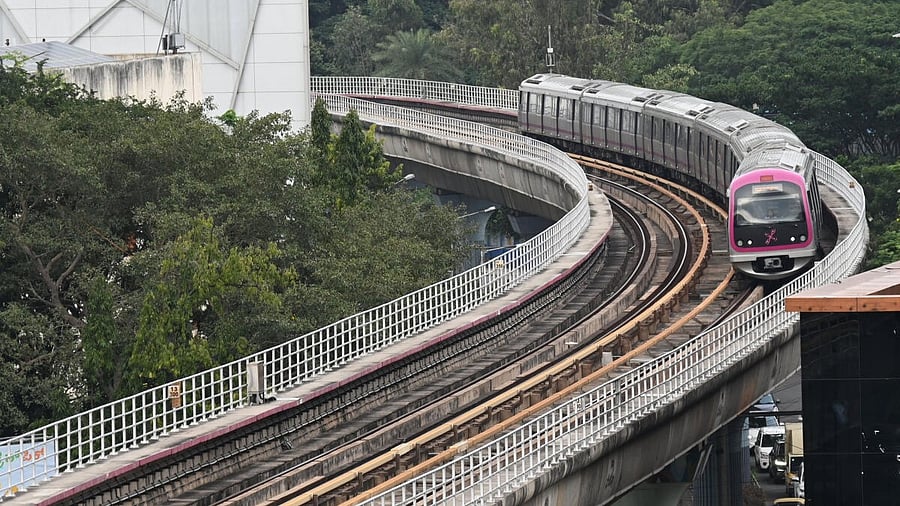
A view of a metro train passing through the Purple Line.
Credit: DH Photo/Pushkar V
Bengaluru: More than half of the Metro stations proposed on the 36-km Hebbal-Sarjapur corridor will feature additional space for parking and property development, a notable shift in outlook for Namma Metro that has been notoriously conservative in both these matters.
The change in thinking comes as Namma Metro looks to boost the non-fare revenue component and reduce dependence on grants from the state government.
According to the detailed project report (DPR), close to 15 lakh square feet of commercial development and about 2 lakh square feet of parking space are planned across 17 Metro stations on the line that will have a total of 28 stations, some of them underground.
At some stations, an additional built-up area of up to 1.6 lakh sq ft is earmarked for 'non-Metro' purposes such as shopping malls and office spaces.
It has been learnt that the Bangalore Metro Rail Corporation Ltd (BMRCL) is keen to partner with private developers for the commercial exploitation of Metro stations, in addition to funding extra floors at some stations at its own cost.
Overall, it hopes the developers undertake more than 75 per cent of the targeted property development, as authorities seek to reduce their dependence on state government grants.
Sarjapur, Carmelaram, Koramangala 2nd Block, Dairy Circle, Basaveshwara Circle, Palace Guttahalli, Mekhri Circle, and Veterinary College in Hebbal are some of the Metro stations where Namma Metro has reportedly made technical provisions in the design stage itself to encourage private investments.
Maheshwar Rao, Managing Director at BMRCL, said property development is the most viable option to increase non-fare revenue.
"Hyderabad Metro has earmarked more than six million square meters of space for property development. We are also considering this approach to reduce our dependence on government grants. While methodology has not been finalised yet, we have the mandate to undertake transit-oriented development," he said.
The 36.58-km stretch will connect IT hub Sarjapur with the Kempegowda International Airport (KIA). Known as Phase III-A, the project, costing Rs 28,405 crore, is expected to be ready in six years after it receives approval from the Union government.
The BMRCL has taken up a similar project on a small scale at its under-construction Nagawara Metro station, where it is building four additional floors.
A BMRCL official told DH that stations located a little away from the road are being targeted for development. "In some locations, we will handle the construction ourselves, as we are doing at Nagawara. In other places, we will issue expressions of interest for investment from private developers," he said.
He noted that underground stations such as Venkateshpur and Tannery Road are being built with strong foundations to accommodate additional floors. "However, we have not yet sought investments at these stations," he added.